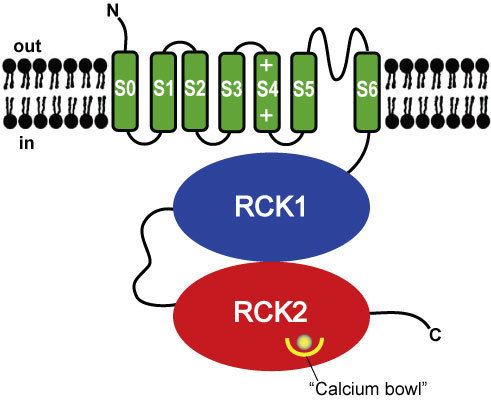Symbol KCNMA1 Entrez 3778 OMIM 600150 | Alt. symbols SLO HUGO 6284 RefSeq NM_002247 | |
 | ||
BK channels (Big Potassium), also called Maxi-K or slo1, are potassium channels characterized by their large conductance for potassium ions (K+) through cell membranes. These channels are activated (opened) by changes in membrane electrical potential and/or by increases in concentration of intracellular calcium ion (Ca2+). Opening of BK channels allows K+ to passively flow through the channel, down the electrochemical gradient. Under typical physiological conditions, this results in an efflux of K+ from the cell, which leads to cell membrane hyperpolarization (an increase in the electrical potential across the cell membrane) and a decrease in cell excitability (a decrease in the probability that the cell will transmit an action potential).
Contents
BK channels are essential for the regulation of several key physiological processes including smooth muscle tone and neuronal excitability. They control the contraction of smooth muscle and are involved with the electrical tuning of hair cells in the cochlea. BK channels also contribute to the behavioral effects of ethanol in the worm C. elegans under high exogenous doses (> 100 mM) that have been shown to correspond to biologically relevant internal ethanol concentrations. It remains to be determined if BK channels contribute to intoxication in humans.
Structure
As with most other voltage-gated potassium channels, BK channels have a tetrameric structure. Each monomer of the channel-forming alpha subunit is the product of the KCNMA1 gene. Modulatory beta subunits (encoded by KCNMB1, KCNMB2, KCNMB3, or KCNMB4) can associate with the tetrametic channel.
BK channels are a prime example of modular protein evolution. Each BK channel alpha subunit consists of (from N- to C-terminal):
- A unique transmembrane domain (S0) that precedes the 6 transmembrane domains (S1-S6) conserved in all voltage-dependent K+ channels.
- A voltage sensing domain (S1-S4).
- A K+ channel pore domain (S5, selectivity filter, and S6).
- A cytoplasmic C-terminal domain (CTD) consisting of a pair of RCK (Regulator of Conductance of K+) domains that assemble into an octameric gating ring on the intracellular side of the tetrameric channel. The CTD contains four primary binding sites for Ca2+, called "calcium bowls", encoded within the second RCK domain of each monomer.
Available X-ray structures:
Pharmacology
BK channels are pharmacological targets for the treatment of several medical disorders including stroke and overactive bladder. Although pharmaceutical companies have attempted to develop synthetic molecules targeting BK channels, their efforts have proved largely ineffective. For instance, BMS-204352, a molecule developed by Bristol-Myers Squibb, failed to improve clinical outcome in stroke patients compared to placebo. However, BKCa channels are reduced in patients suffering from the Fragile X syndrome and the agonist, BMS-204352, corrects some of the deficits observed in Fmr1 knockout mice, a model of Fragile X syndrome.
BK channels have also been found to be activated by exogenous pollutants and endogenous gasotransmitters carbon monoxide and hydrogen sulphide.
BK channels can be readily inhibited by a range of compounds including tetraethylammonium (TEA), paxilline, Limbatustoxin, and iberiotoxin.
The BKCa-channel blocker GAL-021 has been investigated for potential use in inhibiting opioid induced respiratory depression without affecting analgesia.
